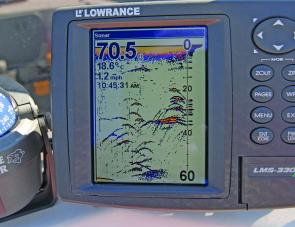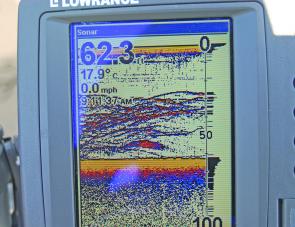Last month we looked at the process of making the twisted leader for our deep fly bass fishing. It is a vital connection between fly and fly line. It is as important as ensuring the fly line and rod match each other in casting weight. Outfits between 6-8 weight are ideal. However, before we try out leader and tackle we need to first find our fish.
If you cannot work out what your sounder is telling you, then finding the fish will be tough. The first step to success on deep-water bass is accurately locating the targets.
In South Queensland impoundments the bass tend to hold along the edges of the deeper flats that drop sharply. Despite the reduced water levels, the bass are still hanging around these areas. Search regions that include creeks and riverbeds or a point of land that drops off into deeper water. The sounder will reveal these features.
The bass at Somerset and Wivenhoe lakes tend to school up and feed in 10-15m of water. However, this is only a rough guide as there are ample variations. For instance, last year we caught fish feeding as deep as 16-18m.
To locate the fish, use the sounder to find a flat or a point leading out to a drop-off. Once there, zigzag back and forth at idle speed and watch the sounder for the fish.
My Lowrance 330LMS sounder/GPS shows schooling bass as clusters of blobs. Depending on the size of the school, the marks will either be scattered over a wide area or tightly bunched. Stopping the boat over the cluster will immediately see the pattern change to arches and turn to strong moving lines. They will move up, down and even crisscross. This is a typical pattern for bass on the chew.
Most sounders are now equipped with GPS which is a great way to track the movement of the fish. Once locating a school, use the GPS to mark the edge of the group. On return visits, the mark can be used as a starting point. If the fish have moved, place another mark over the new area. This will reveal the direction of the fish movement and enable the angler to work the school between the two points. If you are without a GPS then a marker-buoy works equally well.
It is best to make long casts, as this will allow the fly to cover more country. The Striper IV extra fast sink fly line should be allowed to sink down to the bottom before being retrieved. The correct retrieval is a series of short (15-20cm) strips with a small pause between each strip.
The time required for the fly to get near the bottom is estimated as three seconds per metre depth. A good tip is to count the time of its descent before commencing the retrieve. This ensures that the fly will be close to the bottom before being worked back through the action.
A bite at 10m or more is not easily felt. At times, the bass will only have a tiny pick, similar to a small whiting’s bite. On feeling that tiny bump, the smart angler will immediately throw a metre or more of slack line through the rod tip. Keep the tip pointing down or even in the water to eliminate all slack out of the system. This allows the fly to sink back towards the fish.
As the fly sinks back, the fish will have another more determined attack, thinking the fly has been wounded. The angler will then feel a really hard tug that can rip line off the reel.
Bass are usually good fighters and the feel of that first bass on a fly rod is what brings the angler back for more. There are usually a couple of solid runs, head shaking and serious argy-bargy and then the bass is reluctantly on the way to the boat.
Flies that work consistently are the renowned Bass Vampire and Bony Bream patterns. If fish are not showing much interest, a change to a chartreuse and white, or red and white Clouser Deep Minnow might bring results. These can be found in most fly stores. They come with glow enamel eyes and can be charged up with a camera flash or torch. The fish seem a bit more attracted to them then flies equipped with plain lead or painted eyes.
Lastly, releasing a fish on top of its school can sometimes cause the fish to suddenly stop biting. To avoid this frustrating occurrence, slip the fish into the live well and release them elsewhere.
Bass on the deep fly are addictive. It is pretty exciting when the sounder lights up with action. However, the success or failure of a session comes down to the skill of the angler. August and September are some of the hottest months to become involved in this rewarding fly-fishing pursuit.
Reads: 2822
The sounder shows a school of bass in deep water while the boat idles over them. Note the arches are individual fish.

The series of dense lines indicate that bass are feeding well. At deep depths it takes a long time for the fly to reach the bottom.

A Somerset bass taken on a Vampire.




